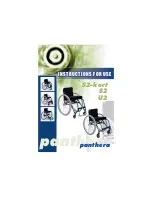
Instructions for use U2, S2, S2-short
Instructions for use U2, S2, S2-short
9
10
Safety
A Panthera wheelchair is designed to be as easy to drive as possible and because of this
it reacts quickly to the actions you perform. If you perform the wrong actions the chair
can tip backwards if you don’t have anti-tips. The chair can potentially tip up and it is
not possible to issue a warning regarding all the circumstances in which that might occur.
The most important safety measures you can take include ensuring that you have tested
the chair thoroughly and spend time practicing your wheelchair technique.
If you have any questions about wheelchair technique you should contact the person who
prescribed the chair/your therapist. If they are unable to help you, please do not hesitate
to contact us at Panthera Production AB. We have a total of over 100 years’ experience of
daily use of wheelchairs. We would like to include some points here that may be helpful
for your safety.
Balance and tipping capacity
The position of the rear wheels, the angle and the adjustment of the backrest uphol-
stery are the most signifi cant factors affecting the wheelchair’s tendency to tip. After
adapting your chair you should check that you feel safe with the balance of the chair.
If you feel unsure, you should use anti-tips or move the rear wheels further back.
The tipping capacity of the chair is also affected by: hanging a bag on the backrest,
leaning/stretching backwards, worn tyres, poorly pumped tyres and unforeseen chan-
ges in the surface you are driving on.
Warning! The chair can tip up on inclined surfaces when adapted in certain ways so use
anti-tips or move the rear wheels further back if you feel unsure of the chair’s stability.
Brakes
If you use our high brakes you should take care not to knock the brake with your
fi ngers when pushing on the pushrims.
If you use high brakes and wish to perform a sideways transfer to or from your
Panthera, it is important that you are able to lift yourself over the brake to avoid sit-
ting on it or getting caught on it.
If you use the single hand brake and are able to stand up, you should be careful not
to open the brakes by mistake with the back of your leg.
Remember that the brakes do not work as effectively on tyres with poor air pressure
or on worn tyres.
If you change to a new brand of tyre you should always check the brakes since the
dimensions may be different.
The brakes are designed as parking brakes and not for braking when in motion.
•
•
•
•
•
•
•
•
Figure 10.
Air points.
Sitting posture
The wrong sitting posture can cause pressure sores. If you are unsure you
should contact your prescriber straight away.
Check that the side guards do not exert too much pressure on your thighs since
this can cause pressure sores. If the side guards exert too much pressure the
chair is either too narrow or the side guards need to be adjusted.
The seat is designed to be used with a cushion.
Driving
If the distance between the lowest point of the footrest and the surface is small
(less than 40 mm) the footrest can get caught on bumps in the surface and
cause you to fall forwards.
If you are pushed or drive down a curb with the anti-tips folded out they can
get caught on the curb and cause you to fall forwards. If you are unsure you
should fold the anti-tips up under the
chair and ask for help.
Transfers/lifting chair and user
The chair is lightweight and for this
reason it can move sideways when the
brakes are on and you transfer from the
side. If you are unsure you should prac-
tice this activity with your prescriber or
therapist.
If the wheelchair is lifted with you sit-
ting in it, the chair should always be
lifted holding the frame and not the
backrest, the push handles, the wheels
or any other parts. See fi gure 10.
•
•
•
•
•
•
•



























